Bohlen-Pierce Scale: modes and chords
Inversions in the Bohlen-Pierce Scale:
One of the most interesting aspects of the Bohlen-Pierce Scale is that it can be used for psychoacoustic studies, such as whether inversions can be heard in non-octave tunings. I created four listening examples here: Hearing Inversions in BP
Early Bohlen-Pierce Scale modes:
This chart shows the modes that were documented when I started my research at NYU in 2001. It didn't take long to come to the conclusion that Lambda mode is the best tonic mode of choice (meaning, just as C Major goes from C to C on a regular piano, Lambda mode would go from C to C on a BP Lambda piano), and most of the prior research also pointed in that direction.
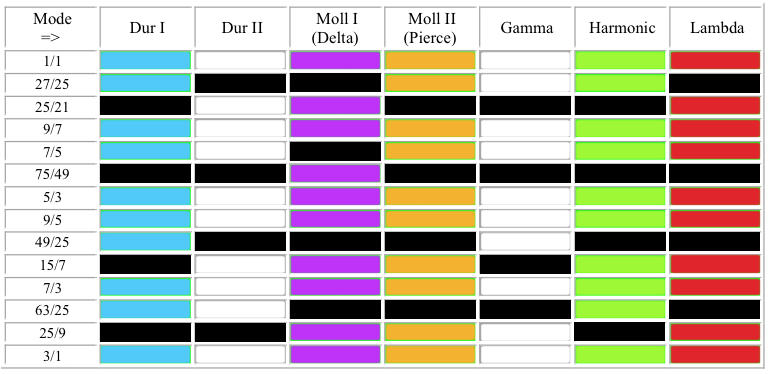
Lambda mode has the ingredients to be a strong sounding tonic mode. It contains all of the frequency ratios that the Bohlen-Pierce Scale was derived from, it starts with a hearty wholetone (whole step) and ends with a lead tone (half step), never has two whole steps in a row, and in my experience, contains a wider variety of harmonic sounding chords than the other modes. In addition, with Lambda as the tonic mode, the other above named modes, with the exception of Dur II and Gamma, fall neatly in the same family, meaning, they can be played on the white notes of the same keyboard.
Listen to the Lambda family of modes below, as well as Dur II and Gamma. Notice that Dur II and Lambda are identical except for the leading tone.
The Lambda family of modes:

Lambda Mode - Listen

Moll 1 (Pierce) Mode - Listen

Harmonic Mode - Listen

Dur I Mode - Listen

Moll 2 (Delta) Mode - Listen
The Dur II family of modes:

Dur II - Listen

Gamma - Listen
One thing that I observed as I re-ordered the modes into a "Lambda family" was that there were four yet-to-be-named modes (D to D, F to F, H to H, and B to B). Apparently this was the first time the modes were put into any sort of logical order.
Four new modes complete the Lambda family:
Also during my studies in 2001, I developed two new modes using a variety of chords and progressions that I derived purely by ear.
Walker I - Listen
Walker II - Listen
Listen to the chord progressions:
Progression 1 | Progression 2| Progression 3 | Progression 4 | Progression 5 | Progression 6 | Progression 7 | Progression 8
Only chord progressions 1, 2 and 3 are shown here.
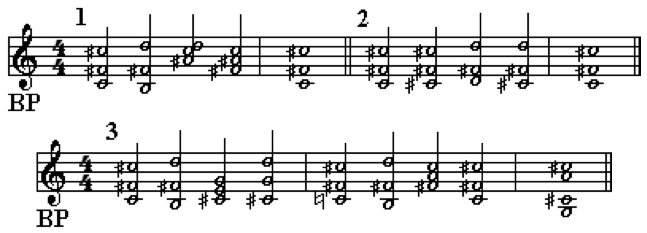
Progression 1 | Progression 2| Progression 3 | Progression 4 | Progression 5 | Progression 6 | Progression 7 | Progression 8
Only chord progressions 1, 2 and 3 are shown here.

I only realized after-the-fact that these two new modes filled two of the four blank spots in the Lambda family (F to F and H to H) and reported this neat finding to Heinz Bohlen. I also pointed out that we still had two blank spots within the Lambda family yet to be named (D to D and B to B). And as I do not like loose ends, I asked Heinz to please name them and fill them in. Funny enough, he named them Walker A and Walker B in his "Lambda Family Wheel." This completed the Lambda family of modes!
Lambda family wheel by Heinz Bohlen, 2001
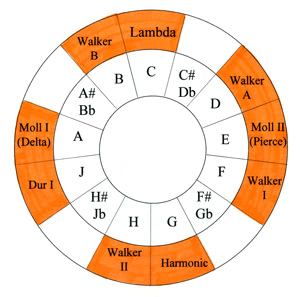

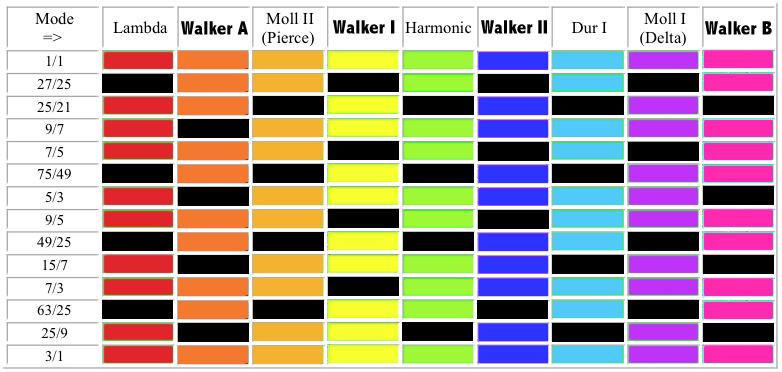
The following charts show modes and chords on the sonome, which is a type of hexagon keyboard. Read about this type of hexagon keyboard here, and see some other examples here. Semitones run horizontally to the right, other different intervals run vertically and diagonally.
Although Lambda is the tonic mode of choice, I sometimes settle on Dur II mode on this particular keyboard because it is visually easier for my eyes to track on the keyboard, with the black notes split up. The only difference is that the A# and B colors are switched. At some point when I was rearranging my first sonome for BP, I realized that Dur II matched Heinz Bohlen's original organ, and I let him know this fun fact. He said his organ most likely was referencing Gamma mode, and to just stick with Lambda or Dur II–that I was probably on the right track.
Using piano-fingers 1 through 4, the modes below can easily be played with the right hand as shown with yellow hexagons. The scale can be played up further, by moving diagonally up to the left, or down further playing diagonally down to the right. The left hand can also play the same thing on the left half of the keyboard, on duplicate notes.
Although Lambda is the tonic mode of choice, I sometimes settle on Dur II mode on this particular keyboard because it is visually easier for my eyes to track on the keyboard, with the black notes split up. The only difference is that the A# and B colors are switched. At some point when I was rearranging my first sonome for BP, I realized that Dur II matched Heinz Bohlen's original organ, and I let him know this fun fact. He said his organ most likely was referencing Gamma mode, and to just stick with Lambda or Dur II–that I was probably on the right track.
Using piano-fingers 1 through 4, the modes below can easily be played with the right hand as shown with yellow hexagons. The scale can be played up further, by moving diagonally up to the left, or down further playing diagonally down to the right. The left hand can also play the same thing on the left half of the keyboard, on duplicate notes.
Bohlen-Pierce Scale, Lambda Mode
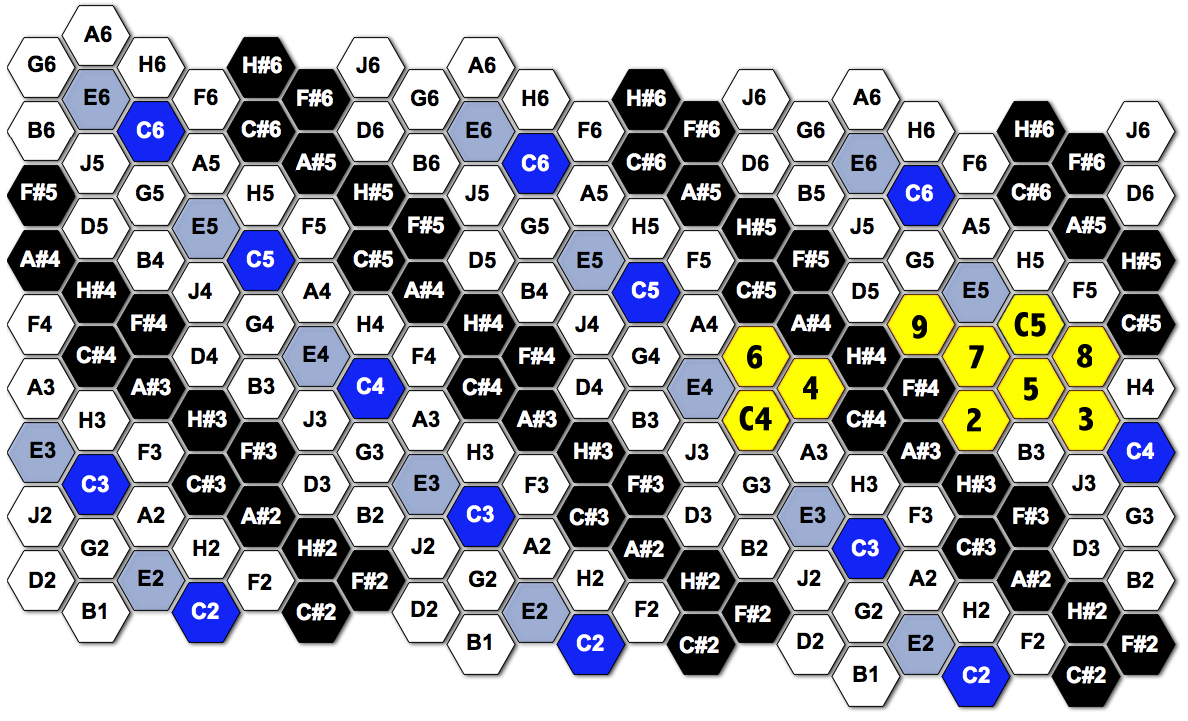

Bohlen-Pierce Scale, Dur II Mode
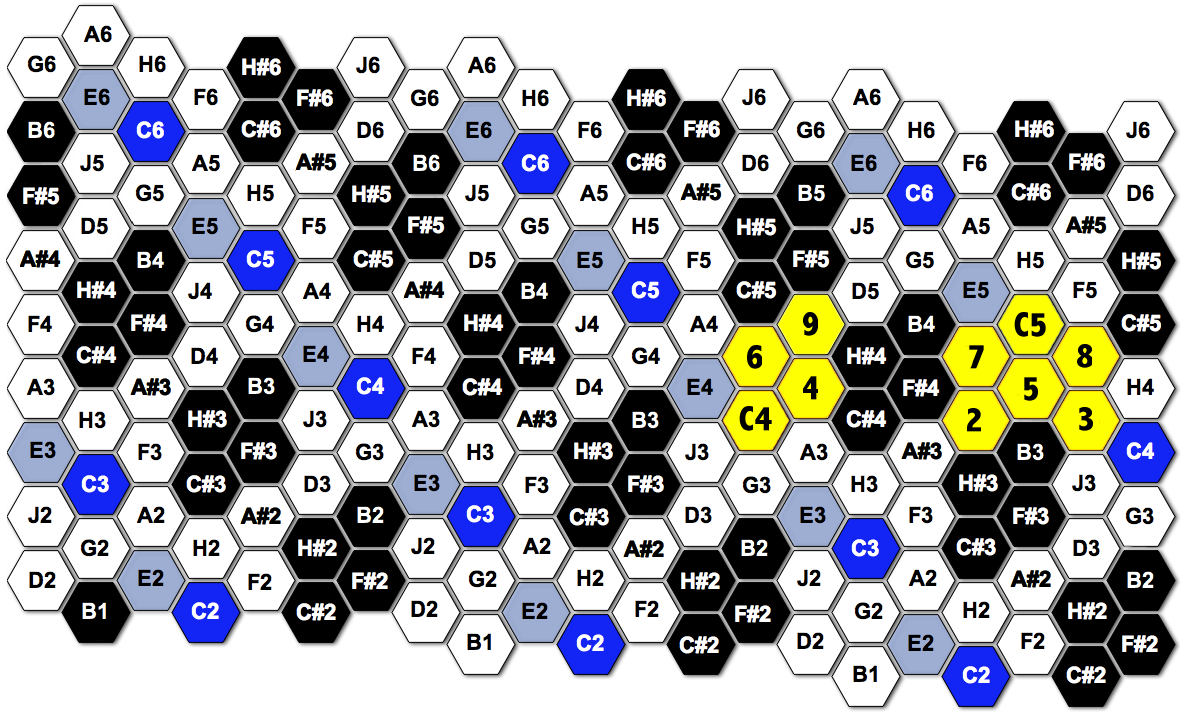

Harmonic Ratios in the Bohlen-Pierce Scale
This shows where the "diatonic" frequency ratios fall on the sonome arranged for Lambda mode. The three charts show (in red) where the Phase I triad (or "Wide" triad), Phase II triad, and Phase III triad (the "Narrow" triad) fall on the keyboard. See my research paper or the official Bohlen-Pierce site to learn more about these ratios and triads.
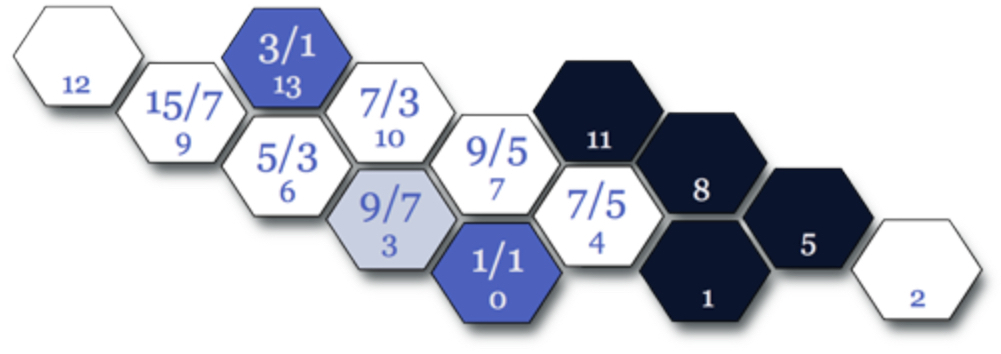
This shows where the "diatonic" frequency ratios fall on the sonome arranged for Lambda mode. The three charts show (in red) where the Phase I triad (or "Wide" triad), Phase II triad, and Phase III triad (the "Narrow" triad) fall on the keyboard. See my research paper or the official Bohlen-Pierce site to learn more about these ratios and triads.

Phase I triad
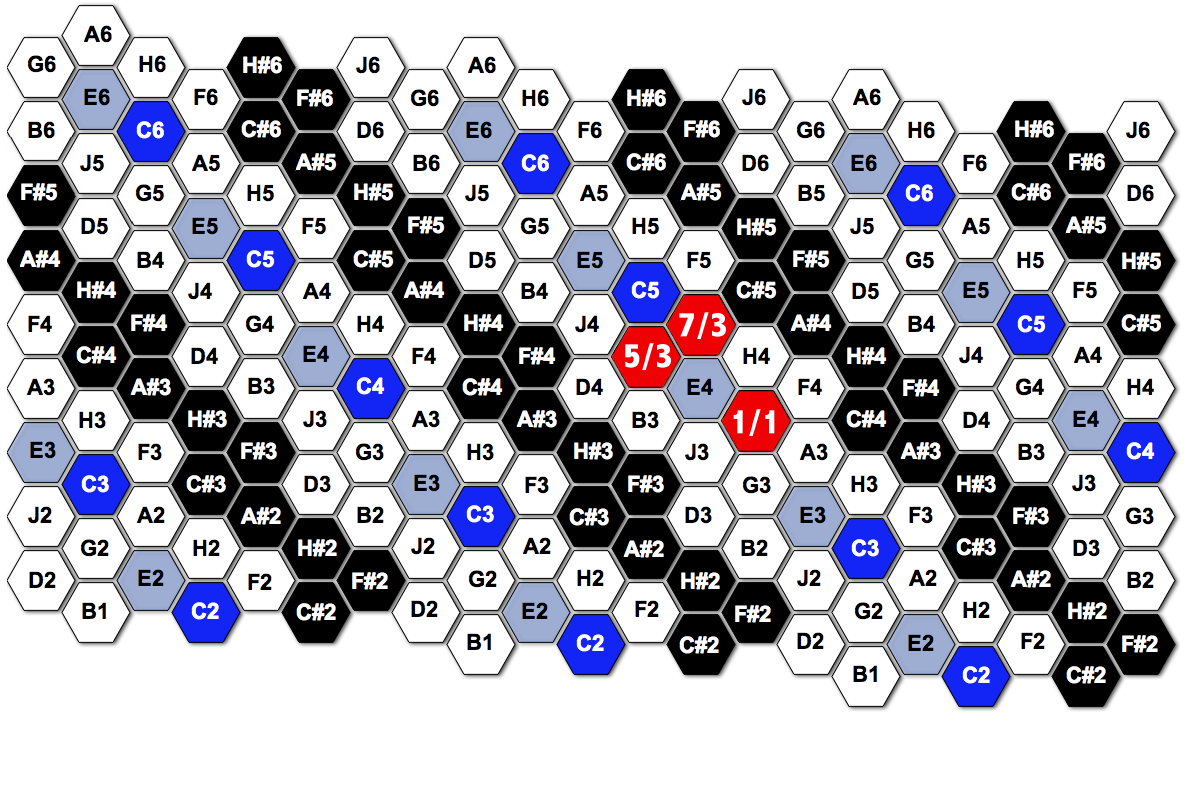

Phase II triad
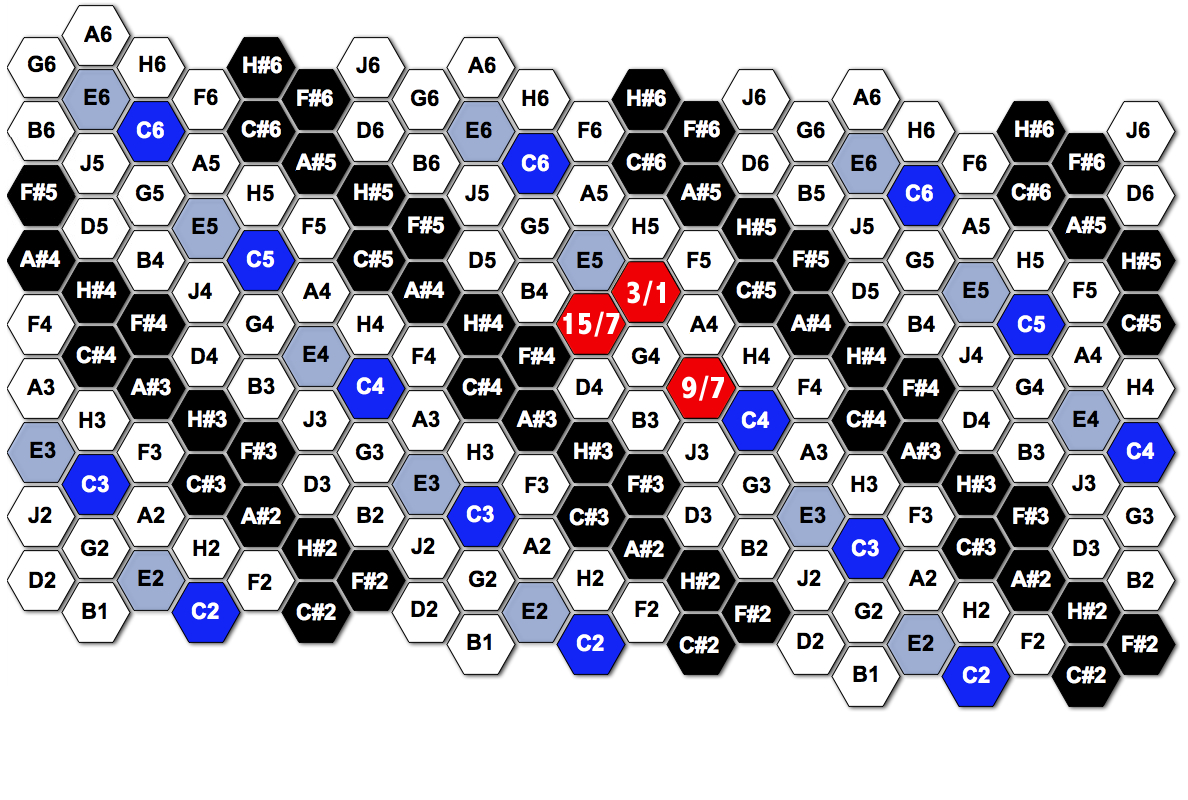

Phase III triad
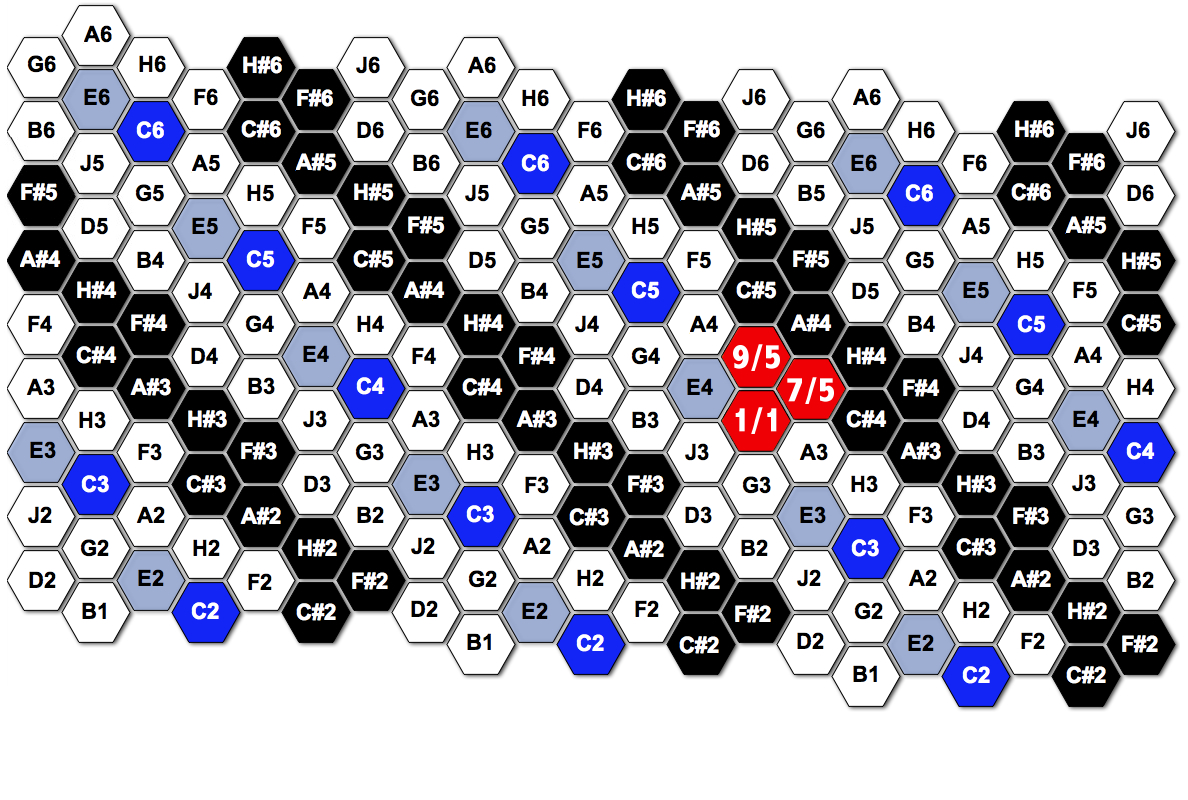

Chords in the Bohlen-Pierce Scale
As I mentioned above, I sometimes use the Dur II Mode layout on the Harmonic Table rather than Lambda Mode because it is easier to "see," with the black keys split up into little islands. The only difference is that the A# and B colors are switched. In my mind I still think of it as Lambda Mode, so I have left the note names the same in these charts.
In addition to the three main diatonic triads above, I've mapped out some chords (below) as an experiment, with the 3's, #4, 5's, 6's and 7's referencing similar intervals in the 12 tone tuning. The Bohlen-Pierce Scale has a harmony all it's own and is completely alien to the 12 tone tuning, however, these chords (sort of) emulate chords that are familiar to Western ears. This is accomplished by playing "10th's" to emulate "3rds", and "12ths" to emulate "5ths", etc, in some cases. The last chart shows a couple of ways to modulate down a "fifth", meaning playing what sounds vaguely similar to playing a V chord going to a I chord in the 12 tone tuning.
I feel this was a necessary exercise, but what will be more interesting will be to find chord progressions that create tension and resolve, but are not familiar in any way to the Western ear. So far, I have not analyzed my own Bohlen-Pierce Music to see what I have done. Whatever I figure out in research goes "out the window" when I compose, and write purely by ear every time. When I get some time I will map out chords in my own BP songs, and add them to this site.
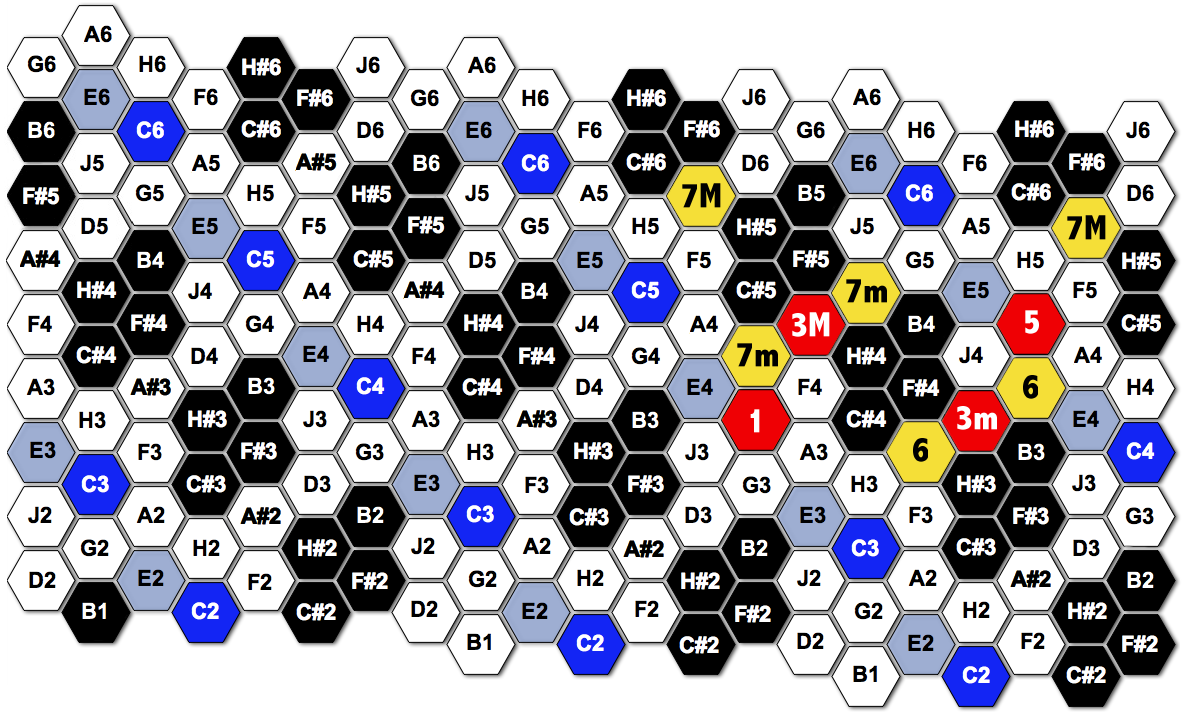
"Major" triad – Play 1 / 3M / 5 to emulate a 12-tone major triad. This is not to be confused with Heinz's original "major" triad which is now called the "wide triad".
"minor" triad – Play 1 / 3m / 5 to emulate a 12-tone minor triad. This is not to be confused with Heinz's original "minor" triad which is now called the "narrow triad".
"6 chord" – Play a "major" or "minor" triad and add one of the two 6's. NOT BOTH.
"minor 7" – Play a "minor" triad with one of the two 7m's. NOT BOTH.
"Major 7" – Play a "major" triad with one of the two 7M's. NOT BOTH.
"Dominant 7" – Play a "major" triad with one of the two 7m's. NOT BOTH.
"minor-Major 7" – Play a "minor" triad with one of the two 7M's. NOT BOTH.
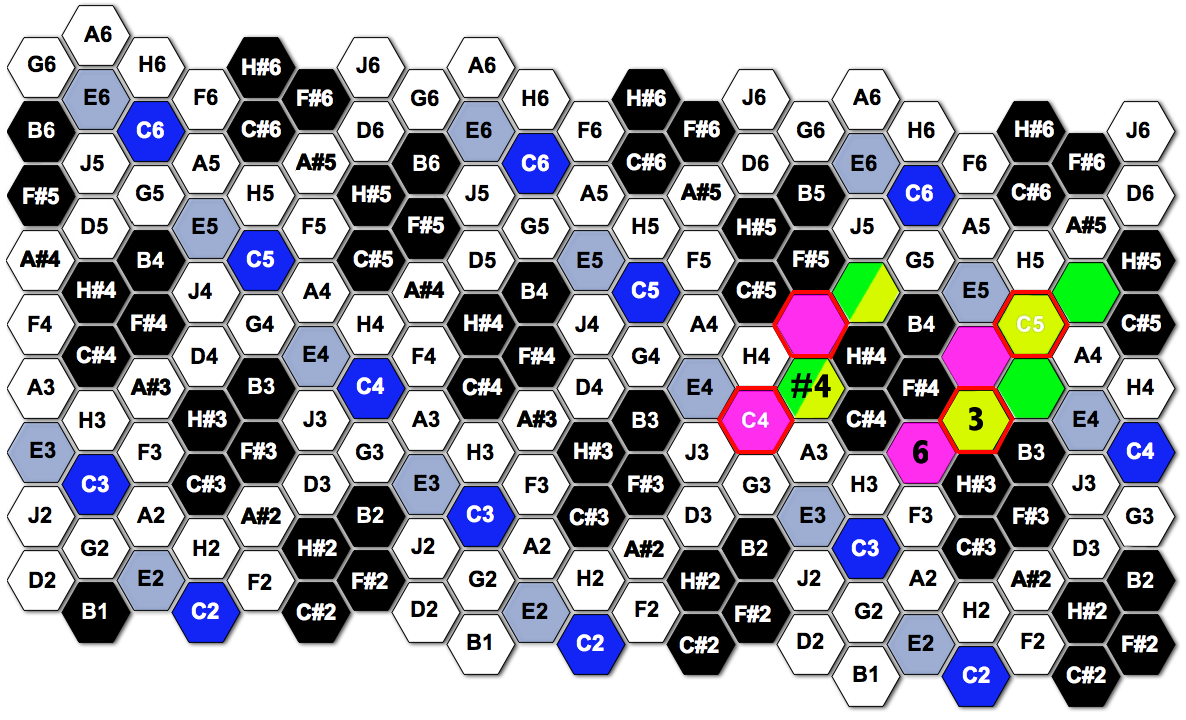
"VI Major and vi minor" (six chords) – Play the pink keys for the VI chords. The upper right pink key is the major 3rd for the VI chord and the lower left pink key labeled "C4" is the minor 3rd.
"III Major and iii minor" (three chords) – Play the yellow keys for the III chords. The upper right yellow key is the major 3rd for the III chord and the lower left yellow key is the minor 3rd.
"#IV Major and #iv minor" chords (sharp-four chords) – Play the green keys for the #IV chords. The upper left green key is the major 3rd for the #IV chord and the lower right green key is the minor 3rd.
The keys outlined in red are the major and minor I chords (the tonic).
There is no sonic equivalent of a IV chord (4 chord) in BP.
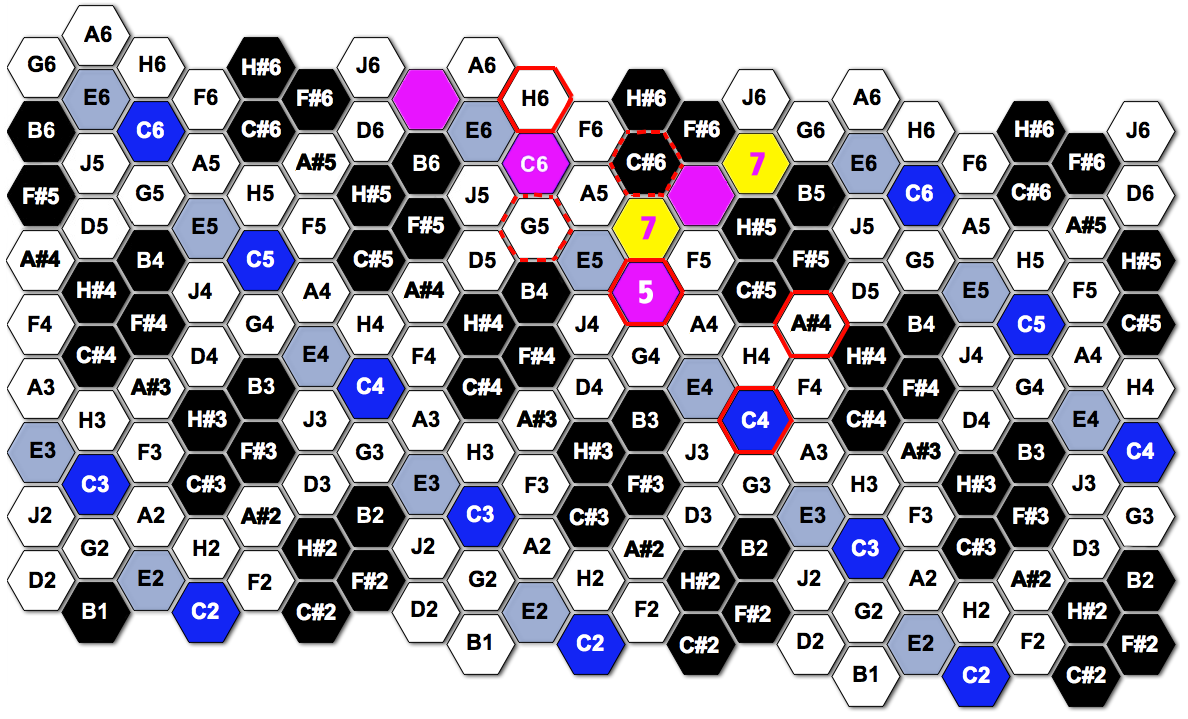
"Resolving down a fifth" (V7 to I Maj)
There are plenty of "7 chords", but it is tricky to "resolve down a fifth" which is what any ear from the Western world will be waiting for. The trick is to resolve to a very wide "I chord".
"V chord" (5 chord) – Play the pink keys labeled 5 and C6, plus one of the other pink keys for the "major 3rd", NOT BOTH. Add one of the yellow 7 keys to create a "dominant 7 chord". This is a different fingering than the dominant 7th cord above, due to the logistics of "resolving down a fifth", as you will see.
"I chord" (1 chord) – The 1 chord notes are outlined in red, or dotted red lines. Play they key labeled C4, 5 and choose the other notes in the chord, keeping leading tones in mind. If you played the topmost pink key, resolve to H6. Don't play G5 or C#6 at the same time. Choose one or the other.
As I mentioned above, I sometimes use the Dur II Mode layout on the Harmonic Table rather than Lambda Mode because it is easier to "see," with the black keys split up into little islands. The only difference is that the A# and B colors are switched. In my mind I still think of it as Lambda Mode, so I have left the note names the same in these charts.
In addition to the three main diatonic triads above, I've mapped out some chords (below) as an experiment, with the 3's, #4, 5's, 6's and 7's referencing similar intervals in the 12 tone tuning. The Bohlen-Pierce Scale has a harmony all it's own and is completely alien to the 12 tone tuning, however, these chords (sort of) emulate chords that are familiar to Western ears. This is accomplished by playing "10th's" to emulate "3rds", and "12ths" to emulate "5ths", etc, in some cases. The last chart shows a couple of ways to modulate down a "fifth", meaning playing what sounds vaguely similar to playing a V chord going to a I chord in the 12 tone tuning.
I feel this was a necessary exercise, but what will be more interesting will be to find chord progressions that create tension and resolve, but are not familiar in any way to the Western ear. So far, I have not analyzed my own Bohlen-Pierce Music to see what I have done. Whatever I figure out in research goes "out the window" when I compose, and write purely by ear every time. When I get some time I will map out chords in my own BP songs, and add them to this site.

"Major" triad – Play 1 / 3M / 5 to emulate a 12-tone major triad. This is not to be confused with Heinz's original "major" triad which is now called the "wide triad".
"minor" triad – Play 1 / 3m / 5 to emulate a 12-tone minor triad. This is not to be confused with Heinz's original "minor" triad which is now called the "narrow triad".
"6 chord" – Play a "major" or "minor" triad and add one of the two 6's. NOT BOTH.
"minor 7" – Play a "minor" triad with one of the two 7m's. NOT BOTH.
"Major 7" – Play a "major" triad with one of the two 7M's. NOT BOTH.
"Dominant 7" – Play a "major" triad with one of the two 7m's. NOT BOTH.
"minor-Major 7" – Play a "minor" triad with one of the two 7M's. NOT BOTH.

"VI Major and vi minor" (six chords) – Play the pink keys for the VI chords. The upper right pink key is the major 3rd for the VI chord and the lower left pink key labeled "C4" is the minor 3rd.
"III Major and iii minor" (three chords) – Play the yellow keys for the III chords. The upper right yellow key is the major 3rd for the III chord and the lower left yellow key is the minor 3rd.
"#IV Major and #iv minor" chords (sharp-four chords) – Play the green keys for the #IV chords. The upper left green key is the major 3rd for the #IV chord and the lower right green key is the minor 3rd.
The keys outlined in red are the major and minor I chords (the tonic).
There is no sonic equivalent of a IV chord (4 chord) in BP.

"Resolving down a fifth" (V7 to I Maj)
There are plenty of "7 chords", but it is tricky to "resolve down a fifth" which is what any ear from the Western world will be waiting for. The trick is to resolve to a very wide "I chord".
"V chord" (5 chord) – Play the pink keys labeled 5 and C6, plus one of the other pink keys for the "major 3rd", NOT BOTH. Add one of the yellow 7 keys to create a "dominant 7 chord". This is a different fingering than the dominant 7th cord above, due to the logistics of "resolving down a fifth", as you will see.
"I chord" (1 chord) – The 1 chord notes are outlined in red, or dotted red lines. Play they key labeled C4, 5 and choose the other notes in the chord, keeping leading tones in mind. If you played the topmost pink key, resolve to H6. Don't play G5 or C#6 at the same time. Choose one or the other.